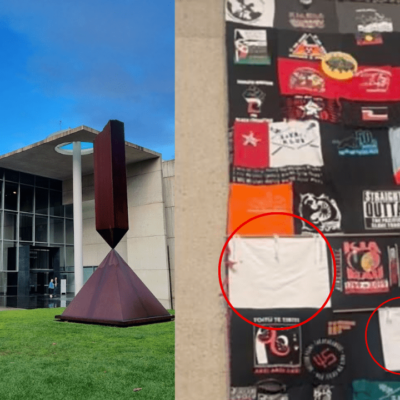
The limitless possibilities of classic rock album artwork

(Credits: Far Out / Raindog Films)
It’s hard to argue Pink Floyd’s Dark Side of the Moon as being music’s most iconic album cover. Simple in its arrangement but delightfully complex in it’s meaning and relationship to the album, it’s a perfect example of how music can be translated into a visual medium.
The artwork is an important part of the album’s journey, cementing its position as a timeless artefact. Sgt. Pepper’s Lonely Hearts Club Band took the newfound psychedelic disposition of The Beatles and presented it to the eyes of the world, while Kendrick Lamar’s To Pimp A Butterfly cover somehow managed to convey the narrative complexity of his album into a still image.
However, while the latter represents a more successful example of a contemporary album cover, there seems to be a dwindling respect for one of the key aspects of an album release campaign. Maybe it’s that, despite the efforts of the vinyl revival, music consumption is largely digital now, and the need for a record to be considered a piece of tangible art is less prevalent. Or even more, it’s perhaps a by-product of the financial scarcity that’s come with the digitalisation of music.
There was a time, however, when album artwork was treated with the same opulence as the music itself. In the highly lucrative 1970s, prolific design duo Hipgnosis pushed the boundaries of album artwork possibilities and stretched wallets in the process.
Comprising of Storm Thorgerson and Aubrey Powell, Hipgnosis became an artistic powerhouse in the world of ‘70s classic rock. Their work was steeped in the surreal, but because of the limited technology available at that time, its methodology was painstaking and presented constant barriers to the realisation of imaginative thoughts.

In an interview with Rolling Stone, Powell said: “We didn’t have Photoshop. Everything had to be shot on film and done by hand. And average artwork could take three to six weeks, whereas you could do some of these album covers in an afternoon now”.
The early days of Hipgnosis thrust a couple of rag-tag artists into cult stardom, and a pair of visionaries quickly gained a fierce reputation for bringing artists’ visions to life. While some of their results were grand, the road that led there was anything but. “London was lawless and you needed to really live on your wits to survive. When Hipgnosis started we had no money at all, it was a question of doing the best we could with what we had” Powell told Huck in an interview.
He continued “Jill Furmanovsky (photographer and Hipgnosis collaborator) says she didn’t know how the quality of the work came out of that studio, but it did. That was because of the attention to detail of Storm and I, but London in the Thatcher years was living by candlelight for three days a week. It was a bizarre time, it’s hard to imagine now that that happened”.
Their reputation to play outside of their means quickly spread about town and Hipgnosis were soon at the helm of classic rock’s most iconic albums. Between Peter Gabriel, T-Rex and Wings, the pair developed what would become their signature partnership, with Pink Floyd.
While Dark Side of the Moon marks their most prized work, they were the duo responsible for famously flying a giant inflatable pig above Battersea Power Station for Animals. A surreal image quite easily recreated on digital platforms today, but in 1977, it was a lofty idea realised by a genuine creation of the event. “I got no permission. There was no health and safety. No demands for anything else,” Powell said in the documentary Squaring the Circle (The Story of Hipgnosis).
But perhaps the best example of the limitless reality Hipgnosis existed in, and a world that feels simply incomprehensible in the modern world, is their cover of The Nice’s Elegy. Along a ridge in the Sahara desert runs several giant red balls in what is an appropriately arbitrary and surreal piece of work from the duo that they admitted had nothing to do with anything but was just “something that felt like the music”.
And on the surface, it’s a relatively simple shot that could have been shot locally and cheaply without any question of doubt. In fact, Tony Stratton-Smith, the man in charge of Charisma records asked if they would recreate the shot in Saunton Sands, to which the pair swiftly replied no, the Sahara.
Recalling the shoot to Huck, Powell said: “Having sold the idea to the record company, the challenge was going to the Sahara, pumping up the balls, taking the picture, and then returning intact to England. Storm and I were joined at the hip in doing that, but we finished up absolutely broke. We still had the balls so we sold them on the market and with the money stayed in the nicest hotel in Marrakech, surviving by the skin of our teeth. Those adventures cement your relationship”.
It’s one of countless tales that water the eyes of modern music fans who are simply unaccustomed to the life of opulence afforded to those working in the heyday of classic rock. But in an era of music when mythology amplifies the power of the music, it’s heartening to know that every aspect of the artistic approach was treated with deep creative intent.
Related Topics







No Comment! Be the first one.